|
"I would not regard even the beginning of our civilization as ancient times. Our civilization exists for some twelve thousand years only... |
Attention! The text below contains complete quotes that are in no way distorted by the article author. Everyone understands the quotes according to his or her spiritual, moral and intellectual development!
A conversation between Graham Hancock and Robert Bauval as cited in Fingerprints of the Gods
THE FIRST TIME
I found the implications of the Orion correlation complicated and eerie.
On the one hand, the Great Pyramid’s southern shafts ‘precessionally anchored’ the monument to Al Nitak and Sirius in 2475-2400 BC, dates which coincided comfortably with the epoch when Egyptologists said the monument had been built.
On the other hand the disposition of all three of the pyramids in relation to the Nile Valley eloquently signalled the much earlier date of 10,450 BC. This coincided with the controversial geological findings John West and Robert Schoch had made at Giza, which suggested the presence of a high civilization in Egypt in the eleventh millennium BC. Moreover, the disposition of the pyramids had not been arrived at by any random or accidental process but seemed to have been deliberately chosen because it marked a precessionally significant event: the lowest point, the beginning, the First Time in Orion’s 13,000-year ‘up’ cycle.
I knew that Bauval believed this astronomical event to have been linked symbolically to the mythical First Time of Osiris – the time of the gods, when civilization had supposedly been brought into the Nile Valley – and that his reasoning for this derived from the mythology of Ancient Egypt which directly associated Osiris with the Orion constellation (and Isis with Sirius).
Had the historical archetypes for Osiris and Isis actually come here in the First Time, twelve and a half thousand years ago? My research into Ice Age mythologies had persuaded me that certain ideas and memories could linger in the human psyche for many millennia, transmitted from generation to generation by oral tradition. I could therefore see no prima facie reasons why the Osirian mythology, with its strange and anomalous characteristics, should not have originated as far back as 10,450 BC.
However, it was the civilization of dynastic Egypt that had elevated Osiris to the status of the high god of resurrection. That civilization was one that had few known antecedents, and none at all recognizable in the remote epoch of the eleventh millennium BC. If the Osirian mythology had been transmitted across 8000 years, therefore, then what culture had transmitted it? And had this culture also been responsible for both the astronomical alignments proven to have been manifested by the pyramids: 10,450 BC and 2450 BC?
These were among the questions I planned to put to Robert Bauval in the shadow of the pyramids. Santha and I had arranged to meet him at dawn, at the Mortuary Temple of Khafre, so that the three of us could watch the sun come up over the Sphinx.
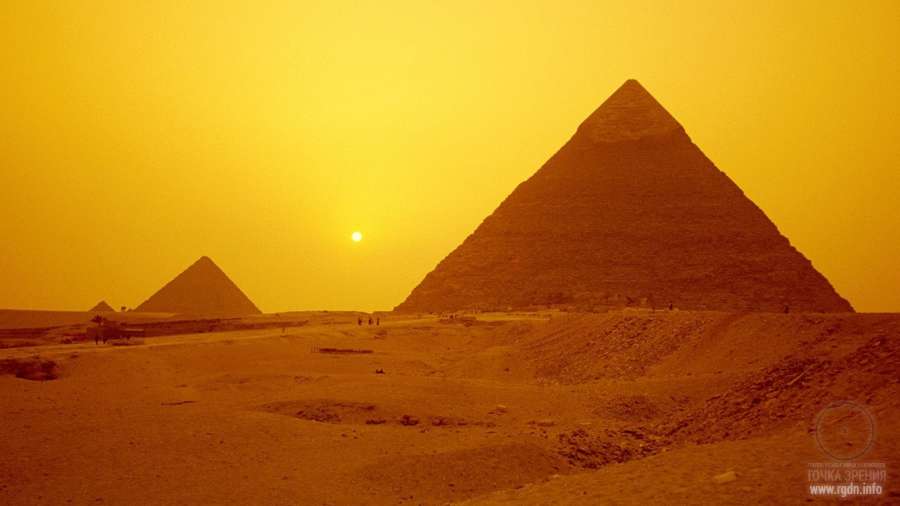
THE PLATFORM
Positioned beside the eastern face of the Second Pyramid, the largely ruined Mortuary Temple was a spooky, grey, cold place to be at this hour. And as John West had indicated during our conversation at Luxor, there could be little doubt that it belonged to the same severe, imposing and unadorned style of architecture as the better-known Valley Temple. Here, at any rate, were the same enormous blocks, weighing 200 tons or more each. And here too was the same intangible atmosphere of vast antiquity and awakening intelligence, as though some epiphany might be at hand. Even in its present, much despoiled state, this anonymous structure, which Egyptologists had called a Mortuary Temple, was still a place of power that seemed to draw its energy from an epoch far in the past.
I looked up at the huge mass of the Second Pyramid’s eastern face just behind us in the pearl-grey dawn light. Again, as John West had pointed out, there was much to suggest that it might have been built in two different stages. The lower courses, up to a height of perhaps thirty feet, consisted largely of cyclopean limestone megaliths like those in the temples. Above this height, however, the remainder of the pyramid’s gigantic core had been formed out of much smaller blocks weighing around two to three tons each (like the majority of the blocks in the Great Pyramid).
Had there been a time when a twelve-acre, thirty-foot-high megalithic platform had stood here on the ‘hill of Giza’, west of the Sphinx, surrounded only by nameless square and rectangular structures such as the Valley and Mortuary Temples? In other words, was it possible that the Second Pyramid’s lower courses might have been built first, before the other pyramids – perhaps long before, in a much earlier age?
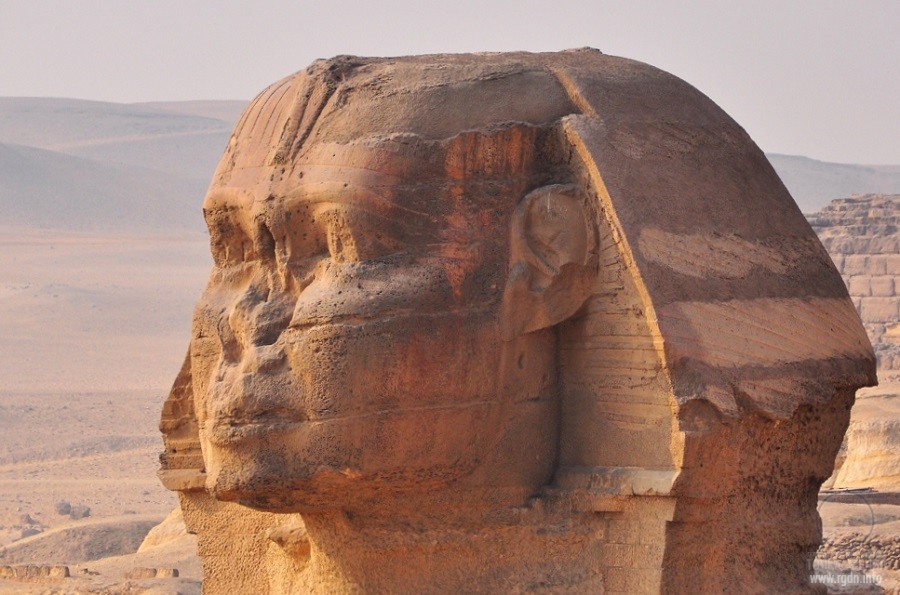
THE CULT
That question was still on my mind when Robert Bauval arrived. After exchanging a few chilly pleasantries about the weather – a cold desert wind was blowing across the plateau – I asked him, ‘How do you account for the 8000-year gap in your correlations?’
‘Gap?’
‘Yes; shafts that seem to have been aligned in 2450 BC and a site-plan that maps star positions in 10,450 BC.’
‘Actually, I see two explanations that both make some kind of sense,’ said Bauval, ‘and I think the answer has to be one or the other of these... Either the pyramids were designed as a sort of ‘star-clock’ to mark two particular epochs, 2450 and 10,450 BC, in which case we actually can’t say when they were built. Or they were built up over...’
‘Hang on with that first point,’ I interrupted. ‘How do you mean ‘starclock’? How do you mean we can’t say when they were built?’
‘Well, let’s assume for a moment that the pyramid builders knew precession. Let’s assume they were able to calculate the declination of particular star groups backwards and towards in time, just as we can today with computers… Assuming they could do that then, no matter which epoch they lived in, they’d have been able to make a model of what the skies over Giza looked like in 10,450 BC or 2450 BC as required, just as we could. In other words, if they’d built the pyramids in 10,450 BC they would have had no difficulty in calculating the correct angles of inclination for the southern shafts so that they would be sighted on Al Nitak and Sirius around 2450 BC. Likewise, if they’d lived in 2450 BC they’d have had no difficulty in calculating the correct site plan to reflect the position of Orion’s Belt in 10,450 BC. Agreed?’
‘Agreed.’
‘OK. That’s one explanation. But the second explanation, which I personally favour – and which I think the geological evidence also supports – is that the whole Giza necropolis was developed and built up over an enormously long period of time. I think it’s more than possible that the site was originally planned and laid out at around 10,450 BC, so that its geometry would reflect the skies as they looked then, but that the work was completed, and the shafts of the Great Pyramid aligned, around 2450 BC.’
‘So you’re saying that the ground plan of the Pyramids could date back to 10,450 BC?’
‘I think it does. And I think that the geometrical centre of that plan was located more or less where we’re standing now, right in front of the Second Pyramid...’
I pointed out the large blocks in the lower courses of the huge edifice: ‘It even looks like it was built in two stages, by two completely different cultures...’
Bauval shrugged. ‘Let’s speculate... Maybe it wasn’t two different cultures. Maybe it was one culture, or cult – the cult of Osiris, perhaps. Maybe it was a very long-lived, very ancient cult dedicated to Osiris that was here in 10,450 BC and was still here in 2450 BC. Maybe what happened was that some of the ways that this cult did things changed over time. Maybe they used huge blocks in 10,450 BC and smaller blocks in 2450 BC... It seems to me there’s a lot here that supports this notion, a lot that says ‘very ancient cult’, a lot of evidence that has just never been investigated...’
‘For example?’
‘Well, obviously the astronomical alignments of the site. I’ve been among the first to start looking into those properly. And the geology: the work that John West and Robert Schoch have been involved in at the Sphinx. Here are two sciences – both hard, empirical, evidence-driven sciences – that have never been applied to these problems before. But now that we have started to apply them, we’re beginning to get a whole new reading on the antiquity of the necropolis. And I honestly think we’ve just scratched the surface and that much more will emerge from the geology and the astronomy in the future. In addition, nobody’s yet made a really detailed study of the Pyramid Texts from anything other than the so-called ‘anthropological’ perspective, which means a preconceived notion that the priests of Heliopolis were a bunch of half-civilized witchdoctors who wanted to live for ever... Actually they did want to live forever but they certainly weren’t witch-doctors... They were highly civilized, highly initiated men and they were, in their own fashion, scientists, as we can judge from their works. Therefore I suggest that it’s as scientific or at least quasi-scientific documents that the Pyramid Texts need to be read, not as mumbo-jumbo. I’m already satisfied that they respond to precessional astronomy. There may be other keys too: mathematics, geometry – particularly geometry... Symbolism... What’s needed is a multi-disciplinary approach to understanding the Pyramid Texts... and to understanding the pyramids themselves. Astronomers, mathematicians, geologists, engineers, architects, even philosophers to deal with the symbolism – everybody who can bring a fresh eye and fresh skills to bear on these very important problems should be encouraged to do so.’
‘Why do you feel the problems are so important?’
‘Because they have a colossal bearing on our understanding of the past of our own species. The very careful, very precise site-planning and setting-out that appears to have been done here in 10,450 BC could only have been the work of a highly-evolved, probably technological civilization. ...’
‘Whereas no such civilization is supposed to have existed anywhere on earth in that epoch...’
‘Exactly. It was the Stone Age. Human society was supposed to have been at a very primitive level, with our ancestors wearing skins, sheltering in caves, following a hunting-gathering way of life and so on and so forth. So it’s rather unsettling to discover that civilized people seem to have been present in Giza in 10,450 BC, who understood the obscure science of precession extremely well, who had the technical capacity to work out that they were witnessing the lowest point in Orion’s precessional cycle – and thus the beginning of the constellation’s 13,000 year upwards journey – and who set out to create a permanent memorial of that moment here on the plateau. By putting Orion’s Belt on the ground in the way they did they knew that they were freezing a very specific moment in time.’
A perverse thought occurred to me: ‘How can we be so sure that the moment that they were freezing was 10,450 BC? After all, Orion’s Belt takes up that same configuration in the southern sky, west of the Milky Way at 11-plus degrees above the horizon, once every 26,000 years. So why shouldn’t they have been immortalizing 36,450 BC or even the precessional cycle that began 26,000 years before that?’
Robert was clearly ready for this question. ‘Some ancient records do suggest that Egyptian civilization had roots going back almost 40,000 years,’ he mused, ‘like that strange report in Herodotus that talks about the sun rising where it once set and setting where it once rose…’
‘Which is also a precessional metaphor…’
‘Yes. Precession again. Most peculiar the way it always keeps cropping up... At any rate, you’re right, they could have been marking the beginning of the previous precessional cycle...’
‘But do you think they were?’
‘No. I think 10,450 BC is the more likely date. It’s more within the range of what we know about the evolution of homo sapiens. And although it still leaves a lot of years to account for before the sudden emergence of dynastic Egypt around 3000 BC, it isn’t too long a period...’
‘Too long a period for what?’
‘It’s the answer to your question about the 8000-year gap between the alignment of the site and the alignment of the shafts. Eight thousand years is a very long time but it isn’t too long for a dedicated highly motivated cult to have preserved and nurtured and faithfully passed on the high-knowledge of the people who invented this place in 10,450 BC.’
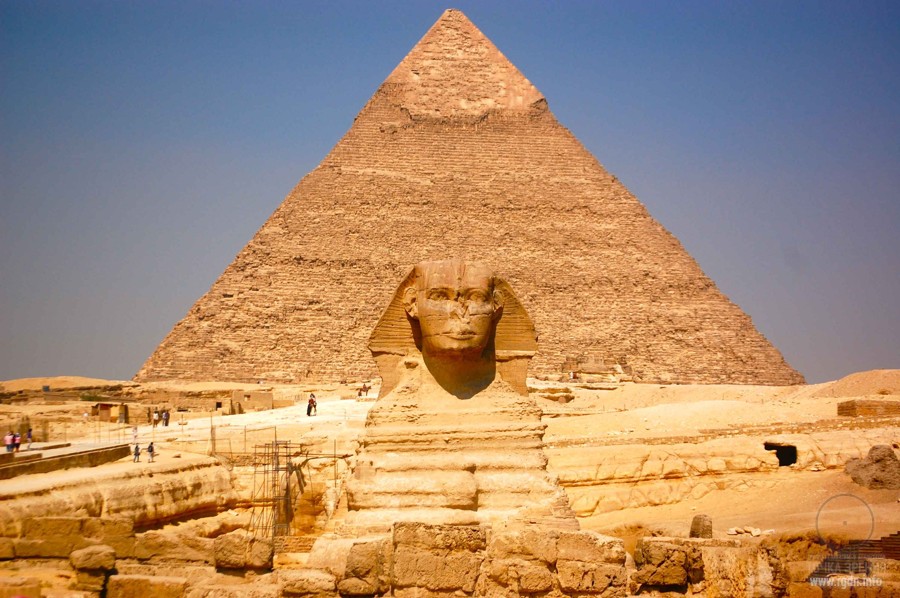
THE MACHINE
How high was the knowledge of those prehistoric inventors?
‘They knew their epochs,’ said Bauval, ‘and the clock that they used was the natural clock of the stars. Their working language was precessional astronomy and these monuments express that language in a very clear, unambiguous, scientific manner. They were also highly skilled surveyors – I mean the people who originally prepared the site and laid out the orientations for the pyramids – because they worked to an exacting geometry and because they knew how to align the base platforms, or whatever it was they built, perfectly to the cardinal points.’
‘Do you think they also knew that they were marking out the site of the Great Pyramid on latitude 30’ North?’
Bauval laughed: ‘I’m certain they knew. I think they knew everything about the shape of the earth. They knew their astronomy. They had a good understanding of the solar system and of celestial mechanics. They were also incredibly accurate and incredibly precise in everything they did. So, all in all, I don’t think anything really happened here by chance – at least not between 10,450 and 2450 BC. I get the feeling that everything was planned, intended, carefully worked out... Indeed I get the feeling that they were fulfilling a long-term objective – some kind of purpose, if you like, and that they brought this to fruition in the third millennium BC…’
‘In the form of the fully built pyramids which they then precessionally anchored to Al Nitak and to Sirius at the time of completion?’
‘Yes. And also, I think, in the form of the Pyramid Texts. My guess is that the Pyramid Texts are part of the puzzle.’
‘The software to the Pyramids’ hardware?’
‘Quite possibly. Why not? At any rate it’s certain that there’s a connection. I think what it means is that if we’re going to decode the pyramids properly then we’re going to have to use the Texts...’
‘What’s your guess?’ I asked Bauval. ‘What do you think the purpose of the pyramid builders really might have been?’
‘They didn’t do it because they wanted an eternal tomb,’ he replied firmly. ‘In my view, they had no doubts at all that they would eternally live. They did it – whoever did it – they have transmitted the power of their ideas through something that is to all intents and purposes eternal. They succeeded in creating a force that is functional in itself, provided you understand it, and that force is the questions it challenges you to ask. My guess is that they knew the human mind to perfection. They knew the game of ritual... Right? I’m serious. They knew what they were doing. They knew that they could initiate people far ahead in the future into their way of thinking even though they couldn’t be there themselves. They knew that they could do this by creating an eternal machine, the function of which was to generate questions.’
I suppose that I must have looked puzzled.
‘The machine is the pyramids!’ Bauval exclaimed, ‘the whole of the Giza necropolis really. And look at us. What are we doing? We’re asking questions. We’re standing out here, shivering, at an ungodly hour, watching the sun come up, and we’re asking questions, lots and lots of questions just as we’ve been programmed to do. We’re in the hands of real magicians here, and real magicians know that with symbols – with the right symbols, with the right questions – they can lead you into initiating yourself. Provided, that is, you are a person who asks questions. And, if you are, then the minute you start asking questions about the pyramids you begin to stumble into a whole series of answers which lead you to other questions, and then more answers until finally you initiate yourself…’
‘Sow the seed…’
‘Yes. They were sowing the seed. Believe me, they were magicians, and they knew the power of ideas... They knew how to set ideas growing and developing in people’s minds. And if you start with such ideas, and follow the process of reasoning like I did, you arrive at things like Orion, and 10,450 BC. In short, this is a process that works on its own. When it enters, when it settles into the subconscious, it is a self-willing conversion. Once it’s there you can’t even resist it...’
‘You’re talking as though this Giza cult, whatever it was – revolving around precession, and geometry, and the pyramids, and the Pyramid Texts – you’re talking as though it still exists.’
‘In a sense it does still exist,’ Robert replied. ‘Even if the driver is no longer at the wheel, the Giza necropolis is still a machine that was designed to provoke questions.’ He paused and pointed up to the summit of the Great Pyramid where Santha and I had climbed, at dead of night, nine months previously. ‘Look at its power,’ he continued. ‘Five thousand years on it still gets you. It involves you whether you like it or not... It forces you into a process of thinking... forces you to learn. The minute you ask a question about it you’ve asked a question about engineering, you’ve asked a question about geometry, you’ve asked a question about astronomy. So it forces you to learn about engineering and geometry and astronomy, and gradually you begin to realize how sophisticated it is, how incredibly clever and skilful and knowledgeable its builders must have been, which forces you to ask questions about mankind, about human history, eventually about yourself too. You want to find out. This is the power of the thing.’

THE SECOND SIGNATURE
As Robert, Santha and I sat out on the Giza plateau that cold December morning at the end of 1993, we watched the winter sun, now very close to solstice, rising over the right shoulder of the Sphinx, almost as far south of east as it would travel on its yearly journey before turning north again.
The Sphinx was an equinoctial marker, with its gaze directed precisely at the point of sunrise on the vernal equinox. Was it, too, part of the Giza ‘grand plan’?
I reminded myself that in any epoch, and at any period of history or prehistory, the Sphinx’s due east gaze would always have been sighted on the equinoctial rising of the sun, at both the vernal and the autumnal equinoxes. As the reader will recall from Part V, however, it was the vernal equinox that was considered by ancient man to be the marker of the astronomical age. In the words of Santillana and von Dechend:
The constellation that rose in the east, just before the sun, marked the ‘place’ where the sun rested... It was known as the sun’s ‘carrier’ and the vernal equinox was recognised as the fiducial point of the ‘system’ determining the first degree of the sun’s yearly cycle...
Why should the equinoctial marker have been made in the shape of a giant lion?
In our own lifetimes, the epoch of AD 2000, a more suitable shape for such a marker – should anyone wish to build one – would be a representation of a fish. This is because the sun on the vernal equinox rises against the stellar background of Pisces, as it has done for approximately the last 2000 years. The astronomical Age of Pisces began around the time of Christ. Readers must judge for themselves whether it is a coincidence that the principal symbol used for Christ by the very early Christians was not the cross but the fish.
During the preceding age, which broadly-speaking encompassed the first and second millennia BC, it was the constellation of Aries – the Ram – which had the honour of carrying the sun on the vernal equinox. Again, readers must judge whether it is a coincidence that the religious iconography of that epoch was predominantly ram-oriented. Is it a coincidence, for example, that Yahweh, God of Old Testament Israel, provided a ram as a substitute for Abraham’s offered sacrifice of his son Isaac? (Abraham and Isaac are assumed by biblical scholars and archaeologists to have lived during the early second millennium BC). Is it likewise coincidental that rams, in one context or another, are referred to in almost every book of the Old Testament (entirely composed during the Age of Aries) but in not a single book of the New Testament?
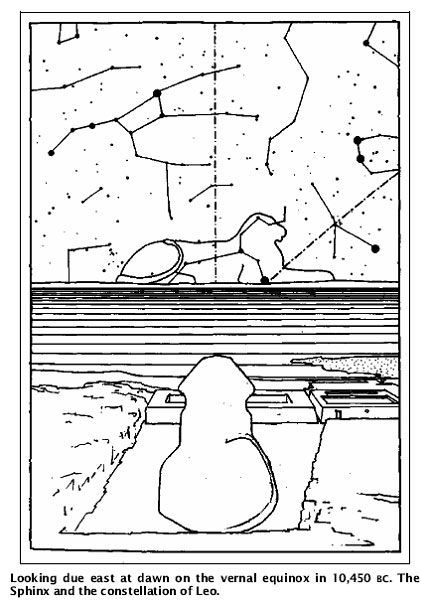
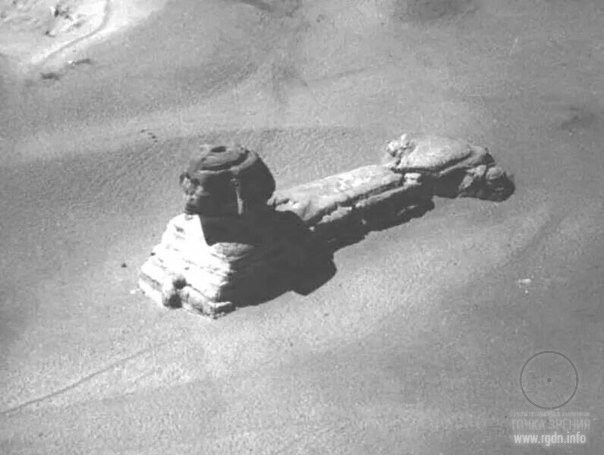
And is it an accident that the advent of the Age of Aries, shortly before the beginning of the second millennium BC, was accompanied in Ancient Egypt by an upsurge in the worship of the god Amon whose symbol was a ram with curled horns? Work on the principal sanctuary of Amon – the Temple of Karnak at Luxor in upper Egypt – was begun at around 2000 BC 23 and, as those who have visited that temple will recall, its principal icons are rams, long rows of which guard its entrances.
The immediate predecessor to the Age of Aries was the Age of Taurus – the Bull – which spanned the period between 4380 and 2200 BC. It was during this precessional epoch, when the sun on the vernal equinox rose in the constellation of Taurus, that the Bull-cult of Minoan Crete flourished. And during this epoch, too, the civilization of dynastic Egypt burst upon the historical scene, fully formed, apparently without antecedents. Readers must judge whether it is a coincidence that Egyptians at the very beginning of the dynastic period were already venerating the Apis and Mnevis Bulls – the former being considered a theophany of the god Osiris and the latter, the sacred animal of Heliopolis, a theophany of the god Ra.
Why should an equinoctial marker have been made in the form of a lion?
I looked down the slope of the Giza plateau towards the great leonine body of the Sphinx.
Khafre, the Fourth Dynasty pharaoh believed by Egyptologists to have carved the monument out of bedrock around 2500 BC, had been a monarch of the Age of Taurus. For almost 1800 years before his reign, and more than 300 years after it, the sun on the vernal equinox rose unfailingly in the constellation of the Bull. It follows that if a monarch at such a time had set out to create an equinoctial marker at Giza, he would have had every reason to have it carved in the form of a bull, and none whatsoever to have it carved in the form of a lion. Indeed, and it was obvious, there was only one epoch when the celestial symbolism of a leonine equinoctial marker would have been appropriate. That epoch was, of course, the Age of Leo, from 10,970 to 8810 BC.
Why, therefore, should an equinoctial marker have been made in the shape of a lion? Because it was made during the Age of Leo when the sun on the vernal equinox rose against the stellar background of the constellation of the Lion, thus marking the coordinates of a precessional epoch that would not experience its ‘Great Return’ for another 26,000 years.
Around 10,450 BC the three stars of Orion’s Belt reached the lowest point in their precessional cycle: west of the Milky Way, 11° 08’ above the southern horizon at meridian transit. On the ground west of the Nile, this event was frozen into architecture in the shape of the three pyramids of Giza. Their layout formed the signature of an unmistakable epoch of precessional time.
Around 10,450 BC, the sun on the vernal equinox rose in the constellation of Leo. On the ground at Giza, this event was frozen into architecture in the shape of the Sphinx, a gigantic, leonine, equinoctial marker which, like the second signature on an official document, could be taken as a confirmation of authenticity.
The eleventh millennium BC, in other words, soon after the ‘Mill of Heaven’ broke, shifting sunrise on the spring equinox from Virgo into the constellation of Leo, was the only epoch in which the due east facing Sphinx would have manifested exactly the right symbolic alignment on exactly the right day – watching the vernal sun rising in the dawn sky against the background of his own celestial counterpart...
FORCING THE QUESTION
‘It can’t be a coincidence that such a perfect alignment of the terrestrial and the celestial occurs at around 10,450 BC,’ said Robert. ‘In fact I don’t think coincidence is any longer an issue. To me the real question is why? Why was it done? Why did they go to such lengths to make this enormous statement about the eleventh millennium BC?’
‘Obviously because it was an important time for them,’ suggested Santha.
‘It must have been very, very important. You don’t do something like this, create a series of vast precessional markers like these, carve a Sphinx, put up three pyramids weighing almost 15 million tons, unless you have some hugely important reason. So the question is: what was that reason? They’ve forced this question by making such a strong, imperative statement about 10,450 BC. Really, they’ve forced the question. They want to draw our attention to 10,450 BC and it’s up to us to work out why.’
We fell silent, for a long while as the sun climbed the sky south-east of the Great Sphinx.
(Fingerprints of the Gods by Graham Hancock)
Read more in the Keeper of Genesis article series:
Prepared by Dato Gomarteli (Ukraine-Georgia)
 “They knew what they were doing…” A conversation between G. Hancock and R. Bauval at the Pyramids of Giza
votes:
112
“They knew what they were doing…” A conversation between G. Hancock and R. Bauval at the Pyramids of Giza
votes:
112
|

Project Aim










Leave comment